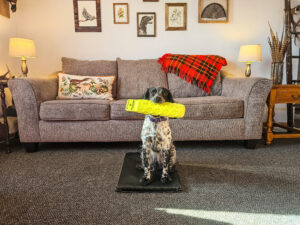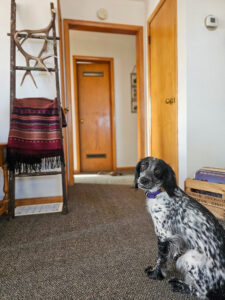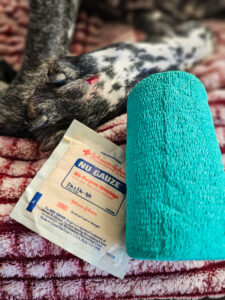A Tired Dog is a Good Dog – Polar Vortex Edition
Written by: Ashley Smith
For most of us, our upland season has come to an end for the year. But, that doesn’t mark the finish line of our journey with our bird dog companions; rather, it signals a shift in focus towards nurturing their skills, reinforcing their training, and deepening the connection that transcends the pursuit of our favorite game. It’s also a time to pause, to reminisce on the triumphs and challenges of the past season, and to celebrate the moments shared in the field – the exhilarating flushes, the steadfast points, and the shared victories that etch themselves into our memories.
In this blog post, we’ll explore some quick and fun off-season training ideas for upland hunting dogs. Consider putting a few of them to work when the weather and long nights take away the option of getting afield. These will soften the sudden disconnect our dogs experience from the hunt and translate to cooperation in the field next season.
From refreshing basic commands to introducing new challenges, we hope that these next few ideas help to kick off your spring training and tire the mind of your ready-to-go bird dog after the shotgun and game bag are put away. After all, the bond of a hunter and their dog knows no season.
 1.) Scent Work
1.) Scent Work
If you’re a dyed-in-the-wool bird hunter or love to pursue other game with your dog, scent work can be a great way to keep them engaged and fulfill their need to find. Hiding items around the house can be great fun for both the dog and handler. This is a great opportunity to foster your search command if already in place, or if you have a young dog during the winter months, this is the perfect chance to build their confidence. Use their favorite item for fetch whether that’s a dummy (pro-tip: Add Wings), a frozen bird or even just a toy! Start by doing short drags and then placing that item in an easily accessible but covered area, you don’t want it to be fully exposed as its possible your dog will just start looking for a visual of the item and not using their nose. Bring your dog to the start of the drag and layer over your preferred word to indicate that you want them to search. Once the item is found a lot of praise should be given! The skills and determination learned here will be used their entire lives. Every success is worthy of a party.
2.) Hallway Retrieves 
No, this is not just for puppies! Practicing retrieves and a seamless delivery are a good way to keep spirits high when the temperatures or snow prohibit spending time outside. A hallway provides one way to and from the handler, and repetitions of hold and release can be fun for the dog with a lot of praise and a favorite bumper. If you do have a young dog, shorter tosses can help their attention span stay with the game and keeps you closer to them in case they need to be reminded to bring it back to you. And remember, keep these sessions short and sweet for puppies. Once the sequence is understood then make take it the full length of the hallway.
For dogs in adulthood, waiting for a calm heel position before throwing the dummy and only retrieving on release is a great way to give them a mental workout. If you always release your dog within 2-3 seconds of the dummy toss, try to change your release times! Count to 10 or 15 seconds. Another variation that I personally love is instead of using a hallway, I will use a staircase. Stand at the bottom, throw up to the landing, release and then have your dog come back to complete the retrieve. This is a great physical workout. Keep an eye on puppies and veteran dogs as to not overdo it.
3.) The Place Command
A highly under-utilized skill that tire even the busiest of bird dog minds is the place command. It’s easy for a high energy dog to pace and constantly be in motion, but a dog learning to slow down can actually make for a great mental training session resulting in a one tired pup (it’s even more taxing if you’re working on this with multiple dogs). You don’t need a place mat to do this. If you have a chair, kennel, or dog bed, even a folded towel or blanket, you’re in business. Invite your dog onto any platform or into their kennel with defined edges and see how long it takes them to step away. Any attempt for them to step off can be met with you blocking that attempt with your body. Or, if you have a leash on the dog (recommended for introduction), use it to guide them back to where you started them. You can then layer a command, “place”, as you ask for the behavior again. Repeat as needed until a little comprehension is shown (your dog called and told us that treats might help them understand faster). You can work your way up to a few minutes at a time, the duration it takes you to cook or eat dinner, or even up to an hour or two if you have guests over. Trust us, Canine Zen is possible.
4. Getting Hands On
Last but not least we should all brush up on handling our dogs. As hunters, we can never predict when they may need to be inspected for cuts, abrasions, ticks, porcupine quills, cactus spines or even need to have first aid performed in the field. Having a dog who is quiet and cooperative for a wellness check can be translated to professional veterinary care as well. 
You can start by asking one of 3 things….either for the dog to stand quietly, sit or even lay on their side. Think about your favorite places to hunt and what kind of hazards you might encounter there and then take into consideration what kind of tailgate first aid or inspections you might need to do and incorporate those into your training. Handle their paws, their legs, get them comfortable with lying down and having someone be really up close and personal. Don’t forget about inspecting their eyes, ears, nasal cavities and teeth too. Practicing this can save you stress in a scary situation when time is of the essence.
We hope that you’ve enjoyed these quick suggestions on some fun wintertime training activities. Remember that any time you spend with your dog(s) who gave so much these last few months is the greatly appreciated by them, and will pay dividends in the long run. Training is a great responsibility to hold as a sporting dog owner and maintaining that bond is a gift!
Ashley Smith is a North Dakota transplant who lives and breathes her bird dogs. She also loves a good vintage book and a snappy Moscow Mule. When not bird hunting, she’s out camping and exploring and ever striving to be a student in all subjects especially if it pertains to nature and all it has to offer. You can follow her and her bird dogs, Ira and Cash, on Instagram @ash.and.cash.
